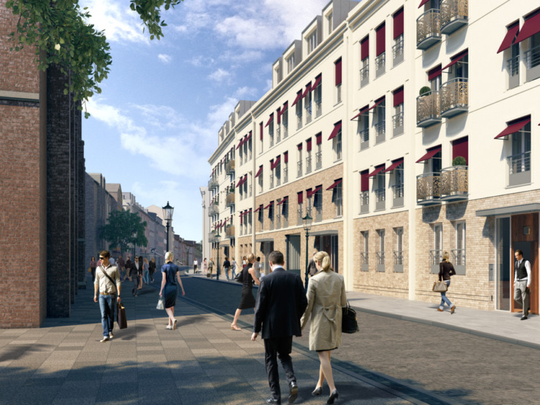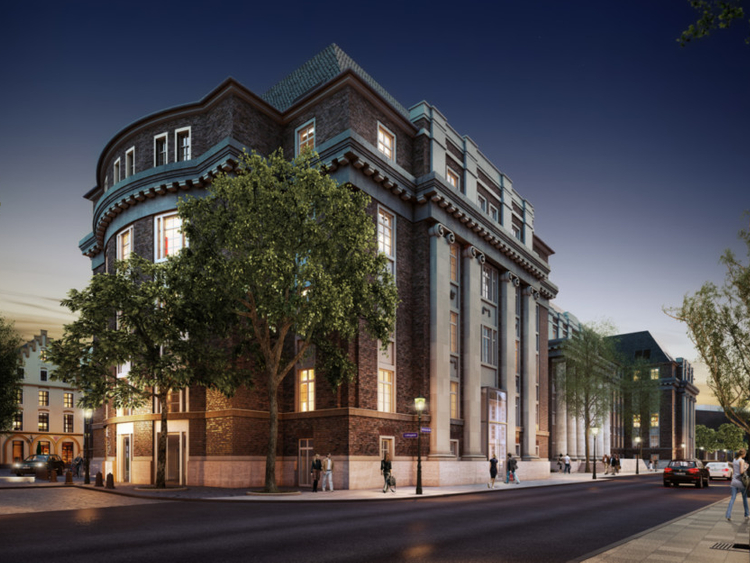
The mention of Duesseldorf is unlikely to make one turn cartwheels. Surely the German city is not that kind of place. As the capital of North Rhine–Westphalia, it is one of Germany’s wealthiest cities — sensible, hard working, big in fashion, film and the arts. But big in partying too. The pubs in the old town are always jam-packed with dedicated drinkers and the city’s carnival goes on for the best part of a week.
So cartwheels? Why not? Legend has it that after a famous victory in the Middle Ages against Cologne, people took to the streets and wheeled away in triumph and even today there is an International Cartwheeling tournament held on the Rhine Promenade.
It is hardly a surprise then, with all this gaiety, that one of Duesseldorf’s most significant developments is to be enhanced by an artist who specialises in trash.
H.A. Schult, who makes life-sized figures out of crushed cans, bottles and bits and pieces of rubbish, is a familiar fixture on the Duesseldorf art scene. Among other apparently eccentric schemes, he has travelled the world photographing streams, lakes and waterfalls and creating pictures of a drop of water many times magnified.
Now a framed image from his work will appear in every hotel room of The Andreas Quartier, an 18,000 square metre construction at the heart of the city’s old town.
The project, which cost €410 million (Dh1.76 billion), was inaugurated on October 11 and is based on a monumental court building built between 1913-1921. It was closed in 2012 by which time the drab post-war legal offices including one Sixties-era ten-storey block which had been built on to the courthouse had declined into an urban wasteland.
This is just the kind of site that attracts the developers Frankonia Eurobau AG whose modus operandi is to concentrate on building in the middle of cities such as Hamburg and Berlin.
“We mostly build in the absolute centre, in the places where the towns were founded and in which people have felt comfortable for centuries,” says Frankonia founder and CEO Uwe Schmitz.
One of his guiding principles is to rehabilitate cities which were heavily damaged during the war and Duesseldorf certainly qualifies for that depressing distinction with up to 90 per cent of its buildings damaged in air raids.
The challenge facing the architects, the local firm SOP, is how to convert a listed building, with all the regulations it entails, into what amounts to four residential and four commercial buildings. More, how to blend it into the surrounding streets, some of which are the oldest in the city.
The old courthouse is an impressive but slightly forbidding edifice which bears the legend above its facade: Built in War and Peace. It’s a tribute to the optimism of the city fathers of the time who refused to let the tumult of the 1914-18 war deter them and somehow it is an admonition not to tamper with the integrity of the place today. It boasts a grand entrance, columns and solid brickwork in the Wilhemian style of the early years of the last century — so-called after Kaiser Wilhelm II, whose inflated ego demanded portentous buildings and grandiose military parades.
SOP has already made a name for itself with sharp contemporary buildings in Duesseldorf such as the 24-storey office block Gap 15, the Hyatt Hotel in the Harbour District and the new Duesseldorf Airport but with this venture they had to maintain the court’s exterior. Inside they had to keep the two vast atriums with their grandiose columns and preserve the granite and marble staircases, the statues and the wrought iron decorations of the balustrades. The cornices and the ceiling mouldings had to stay and the walls painted the same dark blue as before in its legal heyday.
The rather austere front facade is to be lightened by filling the existing terraces with café tables and umbrellas which spill out from the complex’s restaurants. Two come from the Danish company Copenhagen Concepts, a Modern Steak House (MASH) and a brasseries and wine bar, the Cafe du Sommelier and there is also a Spanish restaurant.
Much of the seating is outdoors to help create a cheerful, cosmopolitan atmosphere. Where once serious legal matters were discussed, the lounges and bars around the vast foyer will be alive with the murmur of conversation, the clinking of glasses and live music.
No wonder Frankonia likes to brand the courthouse as ‘Duesseldorf’s Living Room.’
A perfect example of the attention to detail is found in the so-called Ackerman Lounge. Josef Ackerman, once the head of Deutsche Bank, was one of six defendants who faced charges of ‘inappropriate’ bonuses. He had to repay €3.2 million out of his own pocket — a mere 20 per cent of his 2005 income.
Another former chairman of Deutsche Bank, Hilmar Kopper received widespread public and media attention in 1994 when he used the word “peanuts” to describe a sum of 50 million Deutsch Marks (about €25 million) which was owed by a fellow businessman who had gone bankrupt.
It’s a complicated story of profligacy in high financial places, but it’s a good joke especially for a room which will be used to hold discreet power meetings. It is only small, but it has been beautifully restored with the same faded red paint, floral patterns and beading which was discovered when its shelves were removed. Even the step up to the dais where the judge sat and passed judgement has had to remain. Only the chandeliers provide a contemporary note.
Beyond the social area of the old courthouse is the first Hyatt aparthotel to be opened in Europe with 102 rooms complete with kitchen suites, living rooms and bed and bathrooms. Guests can stay for as long as they like and their stay will be enlivened by Herr Shult’s photographs with a different image for every room.
And then you step through a door, like opening a way to Narnia, to discover 270 private flats set around a courtyard of plants, brightened by penstemons and buddleia and a pretty pool.
Home to 500 residents the flats are built of natural stone and brick with balconies and terraces on the ground floor. The interiors have high ceilings and lots of oak fittings. Classy. More than half of the apartments are already sold but a one room apartment can be snapped up for €1 million (about €4,000 per square metre) or rented at €3,000 a month. A penthouse of more than 300 square metres with three floors, a huge terrace and views over the old town and the Rhine costs about €4 million. There are underground car park spaces for 635 cars.
Separated from the main complex by another garden is a block of 84 flats for rental only and what is called the Lifestyle House which will have 650 work places. Again, the architects had to be aware of the surroundings and the history. The highlight of the Lifestyle House is the facade of the former Spinrath Palace which had been turned into a home by the Duesseldorf master builder Adolf of Vagedes in 1812 in a mix of the baroque and early classical. Damaged in the Second World War, the facade is also protected and to add to the challenge it had to be integrated into the surrounding small streets which are among the city’s oldest and most colourful.
Many locals feared a discordant clash of styles but the architects, instead of matching the historic fabric of the old houses in some sort of pastiche, kept the new building unashamedly contemporary with large windows suitable for office life but ensured they did match the surrounding architecture with pointed gabled roofs.
“The facades of the new houses fit in proportion to the court building as well as to the neighbouring buildings of the old town,” says architect Jascha Klusen from SOP. “They are five floors like the others in the area and the long front of the new buildings is divided into small parts, some with balconies and blinds adapting to the character of the district but behind the fronts are hidden modern dwellings.”
The Italian restaurant also has seating on the street which helps connect the development to the busy cafe society outside.
The ambition of the entire concept chimes in with the aspirations of a city that is burgeoning after years of decline. Like so many industrial centres, Duesseldorf was badly hit as Western economies shifted from manufacturing and transport to information and finance. When one of the city’s largest companies, industrial conglomerate Mannesmann, closed its operations, many lost their jobs and the harbour itself became dilapidated.
Now Duesseldorf is an international business and financial centre, renowned for its fashion and trade fairs. The city is headquarters to one Fortune Global 500 and two DAX companies. Messe Duesseldorf organises nearly one-fifth of the top trade shows in the country and the hotel search company Trivago is opening a shiny new office in the Harbour District.
The Japanese are here in force with 7,000 working in 380 of their national companies and, a sign of its global importance, a magazine is published in Arabic for Middle Eastern visitors and businessmen. The airport is one of the busiest in Germany — far bigger than Berlin, for example — and the commutes by road and rail to major cities such as Essen and Munchen-Gladbach are excellent.
Many more businesses have looked at settling in the city in the wake of the uncertainty of Britain’s departure from the European Union.
This boom is reflected in some spectacular postmodern architecture in the redeveloped Harbour District, including three twisted constructions by Frank Gehry, spiralling and stretching into the sky with mirrored walls and matte white finishes. The eye-catching Capricorn House clad in red panels is a model of energy-efficient design and Frankonia itself is meeting a gap in the market by building two twin residential towers on the waterfront.
These have been built on virtually empty sites and have had the architectural freedom to express themselves without much constraint, but AQ — as it is branded — has had to make a special effort to recognise the past as well as the present.
It is not just that the cobbled streets around the Quartier are among the most attractive in the city but they are at the heart of the city’s social life. It is here that people throng to meet and drink the area’s strong, dark, Alt Bier and some hostility was brewed in the taverns at such a smart, such a substantial, intruder.
But the developers are aware that context is important, not just in the design of the flats that now line the streets but in terms of the history. They are keen to celebrate the story of Johanna ‘Mutti’ Ey who had a bakery and a café during the two world wars in Ratingerstrasse. She granted loans to young artists and allowed them to pay with their paintings. Later she opened a gallery, which welcomed many artists, among them Otto Dix and Max Ernst. The gallery was closed in 1934 for its support of ‘degenerate artists’ but now a smart glass box of a building pays tribute to her life, not just by baking bread especially for the Quartier but with gallery spaces where students of the city art academy can show their works.
In fact, so important is art to Duesseldorf that the Hyatt will even supply a specialist concierge to guide the visitor around the 26 museums and more than 100 galleries that grace the city.
As Herr Schmitz explains: “The planning process can often take 10 or more years but I will not allow anybody to lose motivation on the last metres and the passion for details. The buildings are meant to stand there for 100 or 200 years. They are meant to please in the long run.”
Richard Holledge is a writer based in London.














